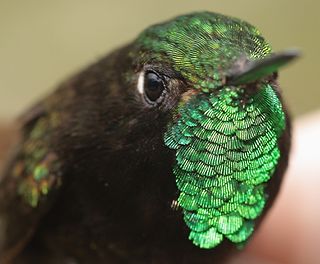
The yellow-throated toucan is a large toucan in the family Ramphastidae found in Central and northern South America.

The recurve-billed bushbird is a Thamnophilid antbird that inhabits dense stands of secondary vegetation at the northern end of the Andes in Colombia and Venezuela. It is named for its extraordinary bill, which curves upwards. Until 2007, the bird was almost unknown in life and apart from earlier specimens it had only been seen in life once at an army ant swarm in Colombia in 1965.

The lazuline sabrewing is a species of hummingbird in the "emeralds", tribe Trochilini of subfamily Trochilinae. It is found in Colombia, Ecuador, and Venezuela.

The Perijá metaltail is an Endangered species of hummingbird in the "coquettes", tribe Lesbiini of subfamily Lesbiinae. It is found in Colombia and Venezuela.

The pale-legged warbler is a species of bird in the family Parulidae. It is native to Argentina, Bolivia, Colombia and Peru. Its habitats include subtropical or tropical moist montane, as well as subtropical or tropical heavily degraded former forest.

The golden-bellied warbler or Cuzco Warbler is a South American species of bird in the family Parulidae. Its natural habitats are subtropical or tropical moist lowland forests, subtropical or tropical moist montane forests, and heavily degraded former forest.

The white-lored warbler is a species of bird in the family Parulidae. It is endemic to the Santa Marta Mountains in Colombia.

The russet-crowned warbler is a species of bird in the family Parulidae. It is found in Bolivia, Colombia, Ecuador, Peru, and Venezuela. Its natural habitats are subtropical or tropical moist montane forests and heavily degraded former forest.

The flavescent warbler is a species of bird in the family Parulidae. Its name comes from flavescent, a yellowish colour. It is found in Argentina, Bolivia, Brazil, Colombia, Guyana, Paraguay, and Venezuela. Its natural habitats are subtropical or tropical dry forest and subtropical or tropical moist lowland forest.

The citrine warbler is a species of bird in the family Parulidae. The term citrine refers to its yellowish colouration. It is found in Bolivia, Colombia, Ecuador, Peru, and Venezuela. Its natural habitat is subtropical or tropical moist montane forests.

The black-crested warbler is a species of bird in the family Parulidae. It is found in Colombia, Ecuador, Peru, and Venezuela. Its natural habitats are subtropical or tropical moist montane forests and heavily degraded former forest.

The smoke-colored pewee is a species of bird in the family Tyrannidae. The species is characterized by a uniform dusky-grey plumage.

The white-sided flowerpiercer is a fairly common and widespread species of Flowerpiercer. Flowerpiercers are a genus of birds within the Tanager family Thraupidae, with specially adapted bills that enable them to pierce the sides of flower blossoms to access the nectar. The white-sided flowerpiercer is found in Colombia, Ecuador, Peru, and Venezuela. Its natural habitats are subtropical or tropical moist montane forests and heavily degraded former forest.

The black flowerpiercer is a species of bird in the family Thraupidae of the order Passeriformes. The family Thraupidae is known for tanagers and other very similar species of birds, but it is still facing classification issues. The black flowerpiercer is found in Colombia, Ecuador, Peru, and Venezuela.

The crested quetzal /ketSAHL/ is a species of bird in the family Trogonidae native to South America, where it is found in Bolivia, Colombia, Ecuador, Peru, and Venezuela. Its natural habitat is subtropical or tropical moist montane forests.

The Perijá tapaculo is a species of passerine bird in the family Rhinocryptidae (tapaculos). Endemic to the Serranía del Perijá mountain range on the Colombia–Venezuela border, the Perijá tapaculo is found at altitudes of 1,600–3,225 metres. Its body is 10 to 12 centimetres long and its tail is about 4 cm (1.6 in) long. Specimens have long been stored in museums, but the species was described only in 2015 based on sixteen specimens found between July 2008 and February 2009. It is considered vulnerable to extinction.

Sierra de Perijá National Park, also known as Perijá National Park, is a protected area in Venezuela. It is located in the Serranía de Perijá mountains on the border with Colombia, to the southwest of Zulia state and Lake Maracaibo. The park was established in 1978 with the objective of protecting the hilly regions.

Myiothlypis is a genus of New World warblers, best represented in Central and South America. This is one of only two warbler genera that are well represented in the latter continent. All of these species were formerly placed in the genus Basileuterus.

The Perijá antpitta is a species of bird in the antpitta family. It is endemic to the Serranía del Perijá on the border of Colombia and Venezuela. In 2016, it was elevated from subspecies of rufous antpitta to full species on the basis of its different vocalizations from the other members of the species complex.




















